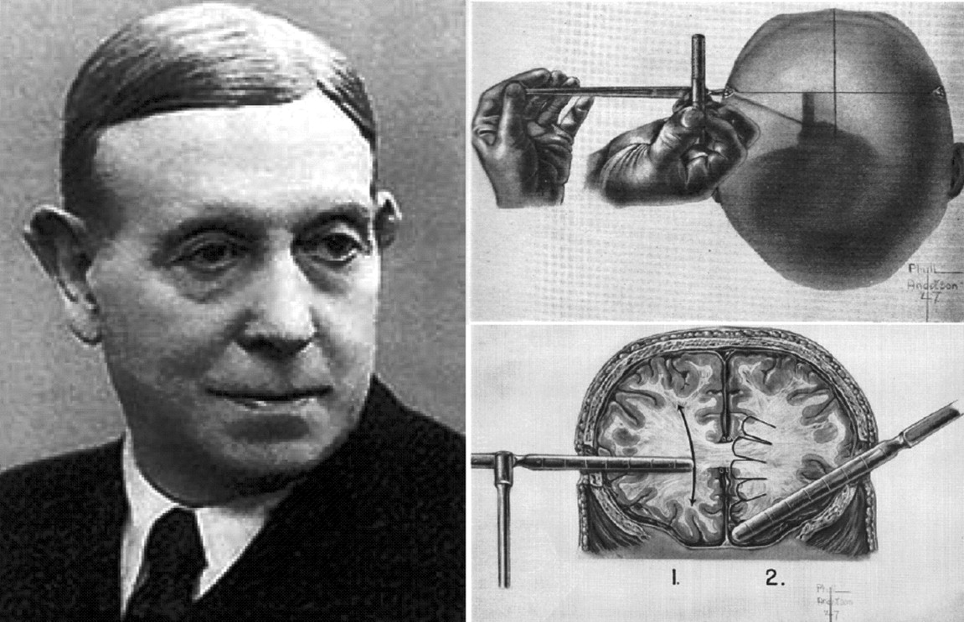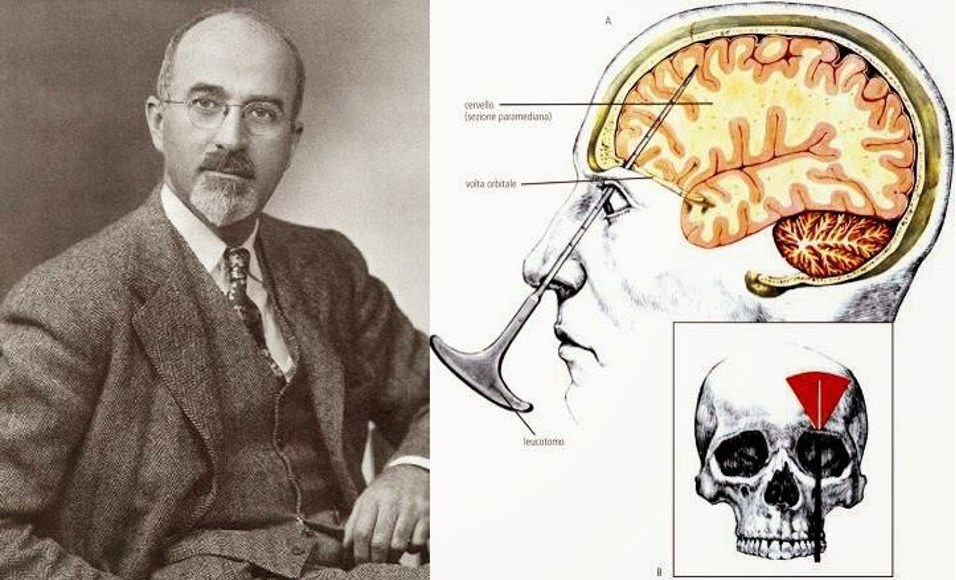Informator uniwersytecki
numer 016
październik 2022
★
5
The power of psychosurgery
It was Portuguese neurologist Egas Moniz who was responsible for introducing the operation into mainstream psychiatric practice. He also coined the term psychosurgery. Moniz developed a theory that people with mental illnesses, particularly "obsessive and melancholic cases" had a disorder of the synapses which allowed unhealthy thoughts to circulate continuously in their brains. Moniz hoped that by surgically interrupting pathways in their brain he could encourage new healthier synaptic connections. In November 1935, under Moniz's direction, surgeon Pedro Almeida Lima drilled a series of holes on either side of a woman's skull and injected ethanol to destroy small areas of subcortical white matter in the frontal lobes.
After a few operations using ethanol, Moniz and Almeida Lima changed their technique and cut out small cores of brain tissue. They designed an instrument which they called a leucotome and called the operation a leucotomy (cutting of the white matter). After twenty operations, they published an account of their work. The reception was generally not friendly but a few psychiatrists, notably in Italy and the US, were inspired to experiment for themselves. In the US, psychosurgery was taken up and zealously promoted by neurologist Walter Freeman and neurosurgeon James Watts. They started a psychosurgery program at George Washington University in 1936, first using Moniz's method but then devised a method of their own in which the connections between the prefrontal lobes and deeper structures in the brain were severed by making a sweeping cut through a burr hole on either side of the skull. They called their new operation a lobotomy.

The 1940s saw a rapid expansion of psychosurgery, in spite of the fact that it involved a significant risk of death and severe personality changes. By the end of the decade, up to 5000 psychosurgical operations were being carried out annually in the US. In 1949, Moniz was awarded the Nobel Prize for Physiology or Medicine. Beginning in the 1940s various new techniques were designed in the hope of reducing the adverse effects of the operation. These techniques included William Beecher Scoville's orbital undercutting, Jean Talairach's anterior capsulotomy, and Hugh Cairn's bilateral cingulotomy. Stereotactic techniques made it possible to place lesions more accurately, and experiments were done with alternatives to cutting instruments such as radiation. Psychosurgery nevertheless went into rapid decline in the 1950s, due to the introduction of new drugs and a growing awareness of the long-term damage caused by the operations, as well as doubts about its efficacy. By the 1970s, the standard or transorbital lobotomy had been replaced with other forms of psychosurgical operations.
Piotr Flieger
Department of Foreign Languages
Did you like it?
Check Piotr's previous articles:
The power of simulation
Watch out fot the opioid painkillers!
Is the human body perfect? Professor Alice Roberts doesn't think so
Four Musketeers or The Lords of the Sith?
Is your brain male or female?
Neri Oxman – mothering mother Nature
Extreme love - dementia
Oh! Women in science...
Just, stop...
Comfortably… alive!
The Edge of Life
E. H. — the Vampire of Silicon Valley
Beauty
Ladies and gentlemen - This is water!
Kisses in a box
Tricks and manipulation strategies the humans employ
The power of simulation
Watch out fot the opioid painkillers!
Is the human body perfect? Professor Alice Roberts doesn't think so
Four Musketeers or The Lords of the Sith?
Is your brain male or female?
Neri Oxman – mothering mother Nature
Extreme love - dementia
Oh! Women in science...
Just, stop...
Comfortably… alive!
The Edge of Life
E. H. — the Vampire of Silicon Valley
Beauty
Ladies and gentlemen - This is water!
Kisses in a box
Tricks and manipulation strategies the humans employ

© 2022 Centrum Symulacji Medycznej UM w Lublinie






